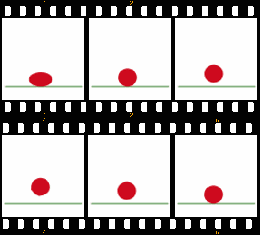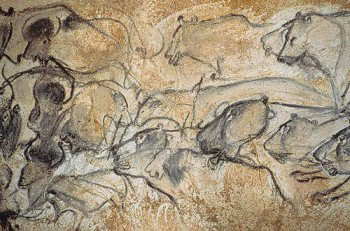Animation
Overview
In 20,000 b.c.e., Paleolithic cave painters attempted to draw moving figures on cave walls by drawing
runninganimals in superimposed positions. The artists worked until their eyes went bad; they got no pay; they got no credit, and they were eventually eaten by wild animals.Animation was born."
— Tom Sito, Drawing the Line: The Untold Story of the Animation Unions from Bosko to Bart Simpson (2006)
 But before we can discuss anything about animation, we have to first answer this question: what exactly is animation? Animation simply isn’t drawing slightly changing figures over and over again and flipping through them quickly—it’s the process of recording an image that goes through continuous motion and shape changes in order to portray the "illusion" of movement. This illusion—as seen in almost all motion pictures in general—is thought to rely on the phi phenomenon, a psychological belief that originated from the work of Max Wertheimer, the creator of Gestalt psychology. According to Gestalt psychology,
But before we can discuss anything about animation, we have to first answer this question: what exactly is animation? Animation simply isn’t drawing slightly changing figures over and over again and flipping through them quickly—it’s the process of recording an image that goes through continuous motion and shape changes in order to portray the "illusion" of movement. This illusion—as seen in almost all motion pictures in general—is thought to rely on the phi phenomenon, a psychological belief that originated from the work of Max Wertheimer, the creator of Gestalt psychology. According to Gestalt psychology, the apparent
[1] Gestalt psychologists developed a set of principles to explain the concept of perceptual organization—how our brains group smaller objects together to form larger ones.[2]movement
created by an ever-changing series of images happens because our minds automatically fill in missing information.
 As referenced in the introduction, the first evidence of interest in the concept of capturing moving figures in a still drawing dates all the way back to early Paleolithic cave paintings, where drawings have shown animals with multiple legs in superimposed positions, clearly attempting to represent some depiction of motion.[3] Animation has, of course, grown since then, and numerous technological breakthroughs have increased the quality of animations that are being produced today.
As referenced in the introduction, the first evidence of interest in the concept of capturing moving figures in a still drawing dates all the way back to early Paleolithic cave paintings, where drawings have shown animals with multiple legs in superimposed positions, clearly attempting to represent some depiction of motion.[3] Animation has, of course, grown since then, and numerous technological breakthroughs have increased the quality of animations that are being produced today.
Modern animation processes have allowed artists to create expansive stylizations of works, allowing them to create films for numerous uses. Popular culture animations include the infamous Duck and Cover (1952) civil defense film, featuring Bert the Turtle, imploring children to duck and take cover under their desks in the event of a nuclear warhead attack,[4] and current "Disney-style" children’s animation shows, like Phineas and Ferb,[5] or full-length feature movies, like Frozen (2013).
Animation is an expansive topic, one that spans over years of evolution and craft that have led it to where it stands today. Together, let’s explore the art of animation.